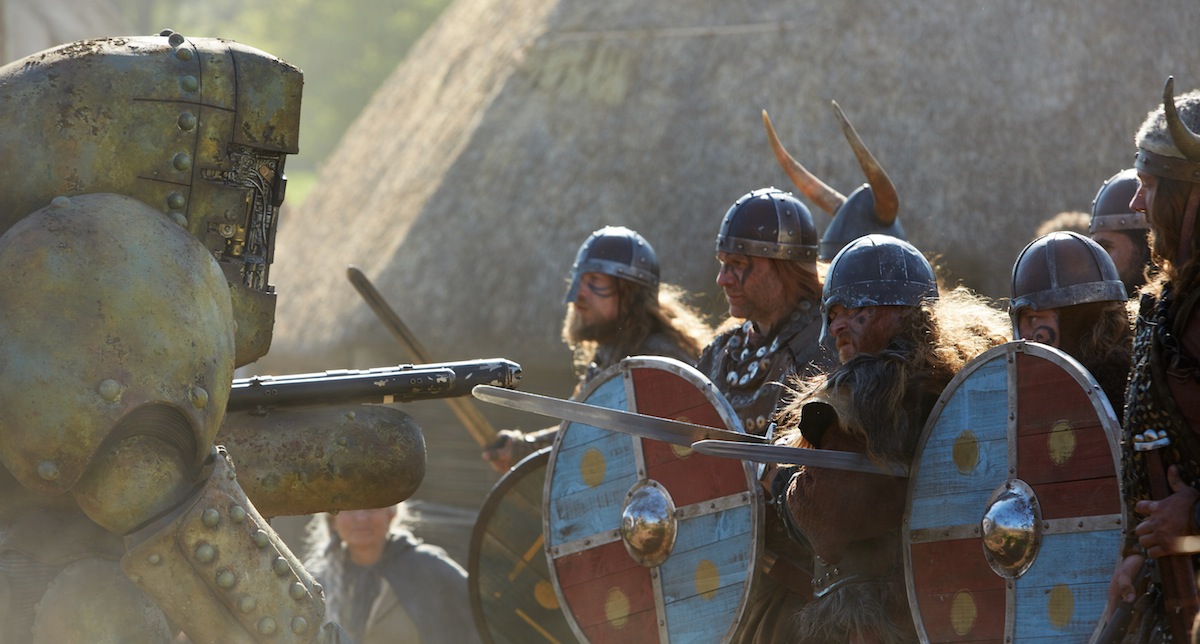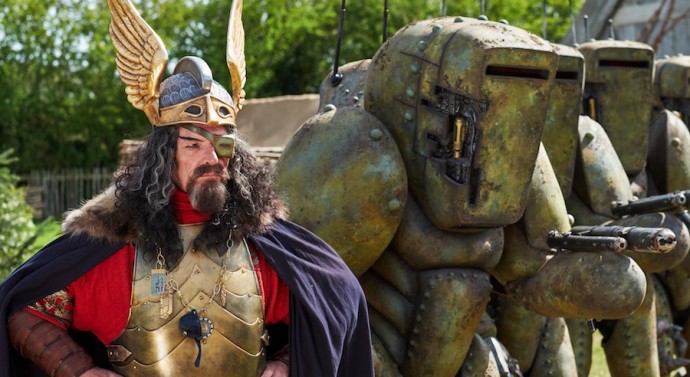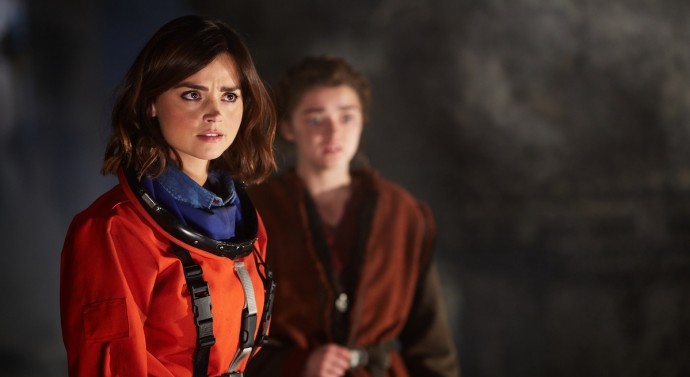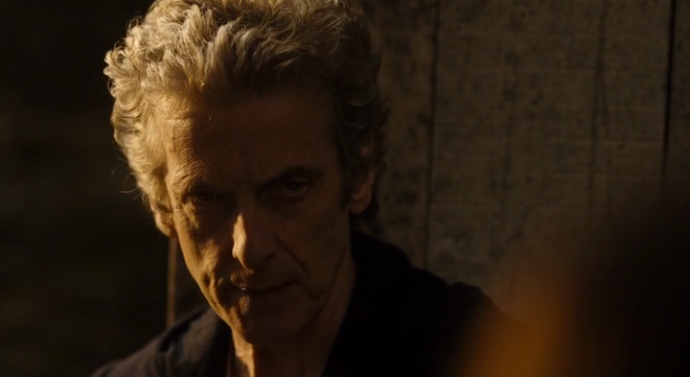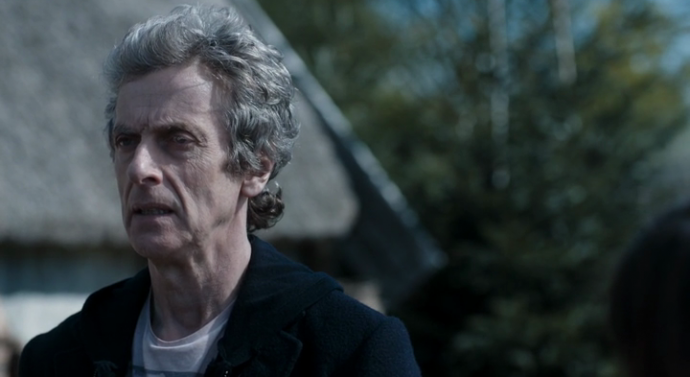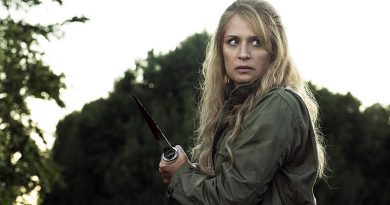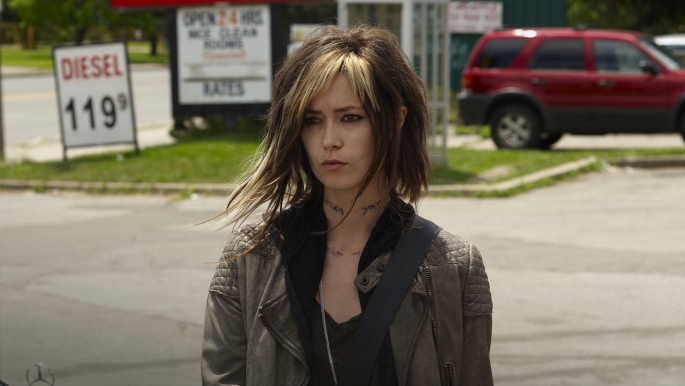DOCTOR WHO: How To Train Your Time Lord

Season 9, Episode 5 “The Girl Who Died”
With tonight’s “The Woman Who Lived” fast approaching, let’s take a look back at the first part of this story, “The Girl Who Died”, shall we?
First though, a shout out to Meghan Young, who I have the good fortune to have serve with me on the board of the Independent Filmmakers Coalition of Kansas City as well as to work with as a filmmaker. This episode marks the first appearance of her work on the production design team for Doctor Who.
While her name isn’t in the credits, because it works like that sometimes, Meg, like bow ties, is cool.
OK, so if you’ve ever wanted to see what happens when you cross Doctor Who with How to Train Your Dragon, well, here you go.
Second: DO NOT STARE DIRECTLY AT THE PLOT.

OK, maybe not that bad, but the A-plot of the story is actually pretty slight, and it’s in the quiet moments that we get our character points, and those, my friends, those are golden this episode.
“The Girl Who Died” is one of the Doctor Who “historical” stories where if you know the history, you may find yourself rolling your eyes at things like Vikings with horns on their helmets and bound books at a time when they certainly wouldn’t have them or be able to read them. You might also know, or learn as I did from another reviewer, that electric eels were nowhere to be found in that part of the world, making the solution to the problem of the Mire a touch more problematic.
No matter. We don’t watch Doctor Who for history lessons.
These Vikings are more the Hiccup variety, with entertainment being the point, and that really is the point of the A-plot overall. Why else would we get Monty Python’s godhead-in-the-sky, the Benny Hill theme, and Vikings with (Doctor-provided) nicknames like Lofty, Limpy, Chuckles and Heidi? Even our villains are a touch silly, with their turning the Viking warriors into testosterone juice. Of course the Mire are a bit more interesting than that, being a race of conquerors who live more by their fearsome reputation than actually by doing the conquest thing. While this provides the seeds of their defeat, it’s also a nice shift from the usual sort of warrior race that features in so much of science fiction.
So ultimately, “The Girl Who Died” is just a fun, funny, fairly slight entry in the quite excellent Series 9, if you’re just looking at the main story of “Vikings under siege from aliens, Doctor comes to save the day”. That, of course, is not remotely all we have here.
OK. Confession time. I am one of the last, what? 5 people on the planet who has never seen an episode of Game of Thrones or read the books? Nothing against the show, and I imagine some week I’ll sit down and binge the thing, but when the books first started coming out, I had been burned out on fantasy (blame Robert Jordan) so they didn’t appeal, and so the arrival of the TV series didn’t move me much. The praise and popularity of the series pleases me as a genre fan, but it’s really come down to the number of hours in a day, and GoT has lost out in that regard.
Consequently, that Maisie Williams was the guest star this episode and the next wasn’t all that big a deal for me. I’d heard she was very good in GoT, but not having that reference point meant not only wasn’t I super excited about her appearance, but I was also able to judge it on its merits, as opposed to any preconceived notions or expectations. And she was OK. I wasn’t blown away, but thought she did a solid bit of acting with a character who seems, if the trailers for “The Woman Who Lived” are any indication, to have more to do in the second part of the story than the first. While that may sound odd, given that Ashildr both sets up the 2nd attack on the village by challenging the Mire and uses her puppet and imagination to drive them away, with the exception of one scene, she didn’t make that much of an impression on me.
That scene is one of the great character moments of the episode, in an episode full of them. As she waits for the morning and the confrontation with the Mire, Ashildr falls back on the comfort of her imagination and her puppets, which is where the Doctor finds her. The strength and comfort she finds in the people of her village, and the acceptance she has found there, standing outside the norms of her culture, is a powerful moment. You can see that the Doctor recognizes a kindred spirit, even as he also recognizes someone who has a sense of home that he never has, outside of the TARDIS. It also sets up the tragic consequences of the Doctor’s later actions, by giving us a sense of what Ashildr will lose by being “saved”. Here, and in her final shot, Williams is excellent, and makes me look forward to seeing what centuries of unwanted life has done to Ashildr.
Of course, as the clear through-line of this season, the Clara/Doctor moments are critical here. From the opening scene to the final discussion of what the Doctor hath wrought, Capaldi and Coleman just shine together. After the uneven Series 8, and the question of what comes after the Impossible Girl in the second half of Series 7, Clara’s journey is much clearer this season, if pointing towards a tragic end.
It’s worth noting here that the idea of the effect the Doctor’s influence on his Companions is a New Series phenomenon. While the book lines let Ace recognize the manipulative nature of the 7th Doctor and leave him in disgust, the Original Series touched only briefly on what travel in the TARDIS did to people. Davies began the deconstruction of the Doctor’s character in “Dalek”, and of course, Moffat kicked it into high gear with the advent of the 11th, but here the influence of both “Fires of Pompeii” and “The Waters of Mars” are close indeed. The “why” of the Doctor is present, of course, but the “what (happens next)” is almost never shown. Consequences are in short supply in the old episodic TV model, but we’ve had the Doctor facing his since we learned of the Time War in 2005.
Davros pointed out to the 10th Doctor that he need not carry a gun, because the Time Lord made weapons of those around him, and while that gives us some great dramatic moments — imagine Rory from the “Eleventh Hour” staring down the Cyber Legion in “A Good Man Goes to War”, and then think about the change in Rory that had to happen to make that scene possible, even leaving aside the centuries as plastic — in “the real world” these adventures, these constant moments of near-death experiences have to have an effect.
Clara, here in her final season, is that effect writ large. From showing the disconnect that the Doctor makes himself feel, because he knows he can’t save everyone, to believing that the Doctor can always win, there is almost a pathology on display here. She knows the Doctor can save the village, because the Doctor saves people, even if the best solution, the one that will save the most lives, is the villagers leaving until the Mire go away. She pushes him, in that subtle, reinforcing, “you can do it, I believe in you” way that friends do, and that is terribly hard to resist, human or Time Lord. That she isn’t being manipulative in a negative sense makes the manipulation no less real, or less damaging to both of them.
And while the Doctor recognizes it, and recognizes what he’s creating in Clara, he can’t just let her go, even for her own safety. At his core, the Doctor is lonely. He lives longer than anyone other than his own people, and even if Gallifrey wasn’t in its bubble universe, he’s not happy with his kind. He’s different, like Ashildr, but without the home that loves him back. And he knows his faults all too well. Being alone is something that is dangerous for someone who knows he can make tidal waves all too easily by helping, or lose his “humanity” by not even being willing to make ripples. The Doctor loves the people who travel with him, because they are the best parts of him, the people who make him the Doctor rather than the Time Lord Victorious.
“Look at you, with your eyes, and your never-giving-up, and your anger, and your… kindness. One day… the memory of that will hurt so much that I won’t be able to breathe, and I’ll do what I always do. I’ll get in my box and I’ll run and I’ll run, in case all the pain ever catches up — and every place I go, it will be there.”
After 2000 years, the Doctor sees what he creates in those who travel with him too long, and what he loses when they are gone.
Perhaps because the arc of Clara is so clear this season, or because she’s so keenly aware that the time is short, Jenna Coleman is on fire this season. We’re 5 episodes in, and there hasn’t been a bad note she’s played, as an actress. You may not like what Clara is becoming, but Coleman is taking us there in confidence and strength.
Peter Capaldi. I will keep saying it… he was born to play this part. It’s fascinating to watch the expert way he’s incorporated all the Doctors before him into his performance, in ways large and so very small. Here, he has a moment where he reaches up to scratch his face in a movement that is so 11th, and he laughs with an ease at times that evokes the 4th, 9th and 11th, while in his painful moments I can see the 7th, 8th and 10th. It’s a masterclass of acting on display, taking 11 other actor’s performances and creating something new out of all of them. He’s not aping the others… he’s absorbed them and created a new Doctor from them. Just stellar work.
We can’t end this without touching on a couple of things. First, the rest of the cast was a lot of fun, from our Vikings to the leader of the Mire, the false Odin. Ian Conningham as “Chuckles”, Ashildr’s father, was especially good, as was Tom Stourton as “Lofty”. David Schofield wasn’t the first choice to play Odin — it was almost Brian Blessed, who had to bow out due to illness — but he does a great job as the bombastic alien, chewing the scenery with gusto.
Second, and critically, we get the answer to question of the Doctor’s face. While there has been a sizable amount of “what, that’s it?” among fandom, there has also been a pretty big contingent that finds the connection to “The Fires of Pompeii” quite satisfying. I fall… somewhere in the middle. Yes, after all the Doctor has been through, a constant reminder of what he is at his best — The Man Who Saves People — isn’t unwelcome. And yet… OK. It’s one thing to give yourself that constant reminder, but do we really need it? While the 12th Doctor began his Incarnation questioning his nature (Am I a good man?), what reason would his internal Doctor — that core personality that every Incarnation is a reflection of — have to think that he needed to wear the face of someone he almost didn’t save? Is it because he had to be asked to save just one family out of the thousands he let die to keep the timeline intact? Is it because he needed a friend to ask him to do more than just be a ripple in time?
Is it because he truly fears that Clara is right, and that he is a tidal wave?
I guess I want more from this… that there should be more to this. The explanation of where the face came from is fine, and the message of keeping him to his mark is valid, but it feels… incomplete, somehow. I’d like to see it play out more as the season and Clara’s evolution continues, but I suspect this is what we get, and if that’s the case, it’s… OK.
Tonight we see the consequences of what that realization drove the Doctor to do, and I do love it when the show shows us consequences. What has Ashildr become because the Doctor saved her?
What will the Doctor be forced to do about it, or become himself because of it?
![]()

